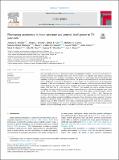Fluctuating asymmetry in brain structure and general intelligence in 73-year-olds
Abstract
Fluctuating body asymmetry is theorized to indicate developmental instability, and to have small positive associations with low socioeconomic status (SES). Previous studies have reported small negative associations between fluctuating body asymmetry and cognitive functioning, but relationships between fluctuating brain asymmetry and cognitive functioning remain unclear. The present study investigated the association between general intelligence (a latent factor derived from a factor analysis on 13 cognitive tests) and the fluctuating asymmetry of four structural measures of brain hemispheric asymmetry: cortical surface area, cortical volume, cortical thickness, and white matter fractional anisotropy. The sample comprised members of the Lothian Birth Cohort 1936 (LBC1936, N = 636, mean age = 72.9 years). Two methods were used to calculate structural hemispheric asymmetry: in the first method, regions contributed equally to the overall asymmetry score; in the second method, regions contributed proportionally to their size. When regions contributed equally, cortical thickness asymmetry was negatively associated with general intelligence (beta=-0.18,p <.001). There was no association between cortical thickness asymmetry and childhood SES, suggesting that other mechanisms are involved in the thickness asymmetry-intelligence association. Across all cortical metrics, asymmetry of regions identified by the parieto-frontal integration theory (P-FIT) was not more strongly associated with general intelligence than non-P-FIT asymmetry. When regions contributed proportionally, there were no associations between general intelligence and any of the asymmetry measures. The implications of these findings, and of different methods of calculating structural hemispheric asymmetry, are discussed.
Citation
Moodie , J E , Ritchie , S J , Cox , S R , Harris , M A , Maniega , S M , Hernandez , M C V , Pattie , A , Corley , J , Bastin , M E , Starr , J M , Wardlaw , J M & Deary , I J 2020 , ' Fluctuating asymmetry in brain structure and general intelligence in 73-year-olds ' , Intelligence , vol. 78 , 101407 . https://doi.org/10.1016/j.intell.2019.101407
Publication
Intelligence
Status
Peer reviewed
ISSN
0160-2896Type
Journal article
Description
SRC, MEB, JMW, IJD were supported by MRC grants MR/M013111/1 and MR/R024065/1. IJD is additionally supported by the Dementias Platform UK (MR/L015382/1), and he, SRC and SJR by the Age UK-funded Disconnected Mind project (http://www.disconnectedmind.ed.ac.uk). The work was done within the University of Edinburgh Centre for Cognitive Ageing and Cognitive Epidemiology; it was funded by the MRC and the BBSRC (MR/K026992/1) and supported SJR, IJD, and JMS. SRC, SJR, MEB and IJD were supported by a National Institutes of Health (NIH) research grant R01AG054628. JMW was supported by the Scottish Imaging Network: A Platform for Scientific Excellence (SINAPSE) collaboration (http://www.sinapse.ac.uk).Collections
Items in the St Andrews Research Repository are protected by copyright, with all rights reserved, unless otherwise indicated.

